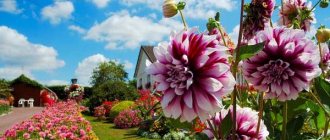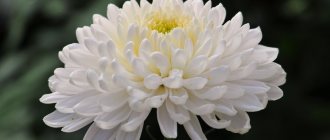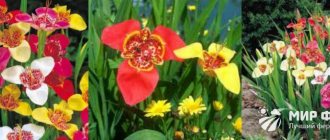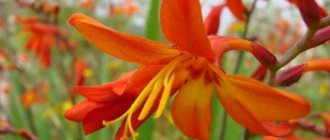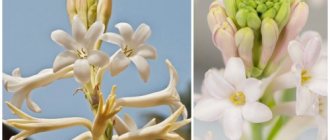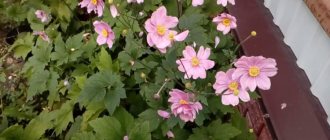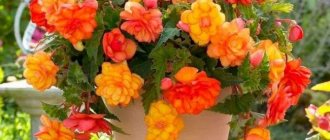Characteristics of dahlias: varieties and varieties
The culture can be roughly divided into annual dahlias (planted in flowerpots to decorate verandas) and perennial dahlias (placed in gardens and flower beds). Each group has its own characteristics, which relate to the principle of planting, appearance and care.
Blooming dahlias
Important! Basically, the difference lies only in the parameters of the aerial parts and buds.
Perennial bushes are very tall and lush. They can grow in one place for more than 2 years. Annuals have miniature forms (usually a low-growing herbaceous base) and are sown as a temporary decoration.
Varieties of varieties
Another difference is the shape of the flower, which determines the main groups of varieties:
- Simple - consist of 1 row of petals and an open center. Outwardly they resemble a colored chamomile. Basic varieties: Princess Marie Jose, Yellow Hammer, Orangeade.
- Anemone-shaped - have several rows of marginal and internal petals. They include varieties such as Lucy, Vera Higgins, Comet.
- Collared - have one row of marginal petals and internal, twisted shape. Varieties: La Gioconda, Chimborazo, Claire de Luna.
- Peony-shaped. The name fully matches the appearance. The most popular varieties are: Symphonia and Fascination.
- Decorative group - represented by varieties David Howard, Thames Valley, Jocondo.
- Globular - Crichton Honey, Doreen Hayes and Esmonde.
- Pom-poms - differ in different colors, among which there is only a blue tint. Varieties: Hallmark, Willo's Violet and Noreen.
- Cactaceae – Visit, Danny, Pirouette, Doris Day.
- Semi-cactus – Yellow Mood, White Swallow, Nantenan, Autumn Fire.
- Nymphaeaceae - they are also called lotus-shaped because of their resemblance to the flower of the same name. Main varieties: Gery Hawk, Genette and Brushstrokes.
Annual varieties
The mixed group has the largest number of different varieties.
Varieties of dahlias with photos and names
The dahlia family has countless varieties.
One of the classifications of dahlias is based on the height of the stem; they differ: tall (up to 150 cm), medium-sized (up to 120 cm), low-growing (up to 80 cm) and dwarf varieties (up to 60 cm).
And also according to the shape of flowers, dahlias are:
- single row
- anemoids
- cactus
- semi-cactus
- spherical
- nymphaeal
- pompons
- collar
- decorative
- mixed
Single row dahlias
Also called simple. As a rule, these are low-growing, non-double varieties with petals in one row.
Happy kiss variety
Anemoid dahlias
Low growing, with semi-double buds.
Variety Lambada
Cactus dahlias
They have numerous petals twisted into tubes that resemble cactus needles. They can have different heights and color variations.
As a rule, they have large flowers, up to 25 cm in size.
Variety Shooting star
Semi-cactus dahlias
They have large double flowers (up to 25 cm in diameter) with petals that are not completely curled. They have a height from 80 cm to 150 cm.
Mick's Peppermint variety
Globular dahlias
Annuals are usually low-growing, with long flowering and a flower diameter of about 15 cm. Their flowers are spherical in shape with rounded petals, twisted into tubes.
Variety Marble Ball
Nymphaeum dahlias
Medium-sized double flowers, in shape actually somewhat reminiscent of a nymphea. Therefore, they are often called lotus. They have large flowers up to 20 cm in diameter.
Bonesta variety
Pompon dahlias
A medium-sized type of dahlia, with unusual spherical double inflorescences (up to 10 cm in diameter), which resemble pompoms. It has a wide variety of colors and is unpretentious.
Variety Franz Kafka
Collared dahlias
In addition to the main row of petals, they have a unique “collar” that differs in color, which gives them an elegant look. Medium-sized, flower diameter up to 10 cm.
Variety Fashion Monger
Decorative dahlias
These include many varieties with different colors and double shapes, with very large flowers up to 30 cm.
Variety Tartan
Mixed dahlias
They are diverse and can combine characteristics of different species. Medium-sized, large-flowered, with various color options.
Gallery Art Deco variety
Varieties of dahlias with video names
To get acquainted with the magnificence of the types and names of dahlias, we suggest watching this video.
There is room to roam, everyone will find a dahlia to suit their taste and color. We showed you only a small part, because the number of dahlia varieties has already exceeded several thousand!
It is important to know: tall varieties bloom later than low ones.
Planting a plant
Dahlias, planted and cared for according to a simple scheme, bloom almost all summer until late autumn. To achieve a riot of colors, it is important to plant flowers correctly.
Planting by seeds
Dahlias Cheerful guys - planting and care
Mostly annual dahlia is planted with seeds. This herbaceous plant has a neat above-ground part. The trunk reaches 30-40 cm in height. Such hybrids bloom profusely and for a long time and are suitable for growing in flowerpots.
Note ! There are two options for sowing: in open soil and in pots with further planting in a flower bed. The first one is more popular, since the seedlings are resistant to adverse weather conditions.
Germination of seeds
How to plant dahlias with seeds:
- Choosing a location. The culture is sun-loving, so it should be placed in an open area.
- Sowing is carried out in May. The plant loves warmth, so you need to focus on the weather.
- Land preparation. It is worth choosing loamy soil. Slightly acidic or neutral soil is suitable. You must first add compost and mineral fertilizers.
- Soaking seeds. They need to be soaked in a fungicide solution to protect them from disease and rot.
- On a flat area, make grooves 2-3 cm deep at a distance of 30-40 cm from each other.
- Place the seeds along the groove at a distance of 30-40 cm. Sprinkle the planting material with soil and water.
- To speed up germination, the bed should be covered with film or glass. When the first shoots appear after 2-3 weeks, the shelter is removed.
Sprouted seedlings
When sowing seeds in a container, the algorithm of actions is the same. True, planting can begin in March-April, since germination will be carried out in greenhouse conditions or indoors.
Planting seedlings
When planting seedlings, you need to choose exclusively sunny areas, but protected from drafts and wind. The soil must be fertilized in advance and well loosened. Sprouts are planted in late May or early June.
The process of planting seedlings:
- Prepare the wells. The depth and width should correspond to the size of the root system of the seedling. The distance between the recesses must be at least 40 cm.
- Lay the sprouts horizontally and dig in so that the root collar is covered with 3-5 cm of soil.
- Water the seedlings generously.
- Cover with film until the temperature at night stops dropping below 10 °C.
Seedlings in open ground
The flower grows quickly, so you need to constantly monitor the height of the film. Otherwise, the trunks will be deformed and will be located horizontally in relation to the ground.
Proper preparation of tubers
Dahlia rhizomes are removed from cold storage at least 2 weeks before planting to awaken the buds and a maximum of 2 months for germination of late varieties and early flowering of middle and late varieties. If you buy planting material in a store or market, do it in the fall, when the rhizomes have just been dug out of the ground and are still fresh. Store them yourself until spring. When purchasing tubers must be:
- elastic, not flabby and not dry;
- without traces of rot or mold;
- without damage;
- with the root collar and the rest of the stem.
Tubers that break off from the stem do not sprout. They don't have eyes like potatoes. The buds are laid only in the upper part, with which they hold onto the stem (root collar).
One tuber can be planted, it will sprout if its upper part is intact - the root collar, there is a bud on it
Stages of preparing dahlia planting material:
- Bring the rhizomes from the cold to the warm gradually: first, keep them for 1-2 days in a cool place, for example, a corridor, near a balcony door, etc.
- Rinse under running water at room temperature.
- Treat in a solution of potassium permanganate, copper sulfate (1 tsp per 10 liters of water) or any fungicide according to the instructions. Let the water drain and dry.
- For germination, prepare boxes, trays, plastic bags, basins, etc. Drainage holes are required to prevent stagnation of water at the bottom and rotting of the tubers.
- Pour a thin layer of loose substrate, lay the rhizomes and pour on top so that the root collar remains open. Wet sawdust, peat, coconut fiber, and sand are suitable.
- Place containers with sprinkled roots in a bright and warm place (+18… +20 °C).
- Moisten the substrate periodically, but do not flood it.
- After 2 weeks, the buds will wake up and you can begin dividing and planting.
The tubers are covered with a moist substrate and germinated in the light
The number of buds will show how many stems each rhizome will produce. You should not think that the more there are, the more magnificent the bush and the more abundant the flowering. It's the other way around - numerous stems crowd each other, spend energy competing for light, water and nutrition, so flowering is sparse.
If the rhizome has 4–5 or more buds, then it makes sense to divide it into parts with 1–2 buds on each. In this case, cuts must be made while grasping the stem in order to preserve the root collars.
The root must be divided so as to preserve the root collars and buds on them
Rhizomes that are too dense can be difficult to divide without damaging the tubers. Powder all the cuts with crushed charcoal or coat them with brilliant green.
Video: dividing dahlia roots
If it is still far from warm, and you need grown shoots for early flowering, then plant the tubers temporarily in pots or buckets with nutritious soil mixture. Once every 10 days, but no later than a week before planting, feed with a complex universal mixture, such as Fertiki Lux.
Watering and loosening the soil
Garden azalea - planting and care in open ground
Caring for dahlias after planting consists of watering the plant and loosening the soil. How to do it correctly:
- When the above-ground part is 10-12 cm high, hilling needs to be done. Form a slide around the trunk. This will help it take root better by sending out additional shoots.
- Watering is carried out once a week, because the crop is drought-resistant. The ground should get wet 30 cm deep. Artificial watering is stopped from mid-August.
- After each watering, you need to renew the hill around the trunk and loosen the soil in the hole. This will help protect the root system from rotting and provide a normal supply of oxygen.
Watering the plant
Note! Hilling is carried out several times per season. The need arises when the position of the bush relative to the ground changes.
To prevent the soil from drying out, you can lay mulch in the hole. But you shouldn’t get carried away - the layer should be minimal. Periodically, you need to remove the mulch to ventilate and loosen the soil.
In addition to watering and caring for the soil, an important rule is the formation of supports for the bushes. The basis for the tether is driven into the ground when planting the seedlings. Do not forget about trimming excess branches and leaves.
When is the best time to dig up tubers?
In the fall, we carefully examine the bushes that are still in the ground. If we see a virus infection, we dig up the perennial along with a lump of earth around the rhizome and burn it.
When storing flowers, it is important what time they were dug up. For high-quality ripening of tubers in August, we stop feeding and reduce watering. As daylight hours shorten in autumn, plants begin to lay buds from which shoots will grow in the spring. If there is a possibility of early frosts, then we insulate the bushes.
For a few days before digging, we remove all the leaves, cut off the stems, leaving 10–15 cm. Cover the sections with aluminum foil so that moisture does not get on them and the rotting process does not begin.
The flowers have a very fragile neck, so we dig them out carefully so as not to damage them. This procedure must be carried out in warm and dry weather, preferably in the morning, in order to have time to dry the roots a little, then the neck will not be so fragile, and there is less risk of breaking off some parts of the flower.
We do the excavation according to the following scheme:
- In order not to damage the tubers, we dig up the bush at a distance of 30 cm.
- Next, we place a fork or shovel under the bush, using it as a lever, pry the bush and push it out of the ground.
- Carefully shake off the soil from the bush, turn it upside down and dry it.
- After digging, wash the tubers with water from a hose. Along with the remaining soil, harmful microorganisms and pathogens that were on the rhizomes will be removed.
It is necessary to process the planting material and prepare it for storage.
Reproduction methods
Sill planting and care in open ground
Dahlia can reproduce in five ways. Each option has advantages and disadvantages, and some are used extremely rarely. Methods of propagation of culture:
- Dividing tubers. The simplest option that will allow you to preserve all the qualities of the mother bush. In the fall, you need to remove the tubers from the ground, wash them, remove dead roots and separate the tubers with your hands. As a result of division, each tuber should have two buds left.
- Vaccination is an infrequent, but very effective type of propagation. Make a conical hole in an old tuber. Sharpen a healthy dahlia sprig and insert it into the tuber. Wrap the joint with cotton wool. Plant the graft into the ground.
- Sowing seeds. This propagation option allows you to get a completely new plant (maternal characteristics are not preserved). When the flower begins to fade, you need to cut it and dry it indoors. Next, the planting material is collected and packaged until spring.
- Cuttings. The method makes it possible to obtain strong plants with high resistance to disease. At the beginning of March, healthy tubers are planted in a box. Proper watering and maintenance is carried out. When the tubers grow, a cutting will appear. After 2-3 internodes appear on the cutting, it can be cut off. Place the sprout in a container with sand.
- Disputes make it possible to obtain a new variety. Cut off a flowering branch and plant in a separate pot. Gradually reduce watering and let the branch dry out. For the winter, place the container in a room with a temperature of 6 °C. In the spring, resume watering in order to plant the bush in open ground in May.
Reproduction methods
Thanks to different propagation methods, it is possible to obtain not only a large number of young bushes, but also completely new varieties.
Germination of dahlia tubers
How and when to plant dahlia tubers for germination, see this video:
Growing dahlias for early flowering
Experienced gardeners advise purchasing dahlia tubers in March and planting them immediately. Of course, planting is not done in the ground, but in a container with soil, and active lighting is used.
In this way, the tubers germinate when there is still a lot of snow outside the window. But they grow, gain strength, and when spring and warm weather arrive, they are ready for planting, large, well-developed plants.
With such early planting and germination, dahlias bloom already in June-July, and not in September.
This method is only suitable if you have the opportunity to highlight the sprouts when the daylight hours are still too short.
If you do not have such an opportunity, then you should not experiment - from a lack of light, the plants will stretch out and be weakened.
Feeding and fertilizers
In order for the bush to bloom luxuriantly and not be attacked by pests, periodic feeding must be done during the growing season. Do the procedure at least 2 times a month. In order for the plant to receive all the necessary substances, you need to alternate the use of mineral and organic fertilizers.
Infusions of mullein, chicken droppings, and ammonium nitrate are used as organic fertilizers. The bush will grow to full size if you add superphosphates or potassium fertilizers when the first two buds appear. You also need to plant the sprouts in well-fertilized soil. It is important not to overdo it with fertilizers, so as not to destroy the flower.
Planting and caring for dahlias
- Planting: from the second half of May to the second half of June.
- Digging: in the fall, after the first frost.
- Storage: at a temperature of 3-5 ˚C and air humidity of 60-70%.
- Flowering: summer and autumn.
- Lighting: bright sunlight.
- Soil: any soil, but preferably rich garden loam with a slightly acidic or neutral reaction.
- Watering: abundant, 1-2 times a week.
- Feeding: organic and mineral every two weeks alternately.
- Garter, hilling, pinching: required for tall varieties.
- Reproduction: seeds, tubers.
- Pests: slugs, earwigs, slobbering pennies, flower beetles, aphids.
- Diseases: powdery mildew, bacterial canker, growth, smut, gray mold and viral mosaic.
Read more about growing dahlias below.
flowers (lat. Dahlia) of the aster family are one of the most beautiful and long-blooming garden flowers, represented by a wide palette of colors and variety of shapes. They bloom from July until frost, and this is the most important advantage of dahlias, besides beauty. The first dahlia tubers were brought to Europe from Mexico at the end of the 18th century. The dahlia received its name in 1803 from the botanist Karl Wildenau, who named the dahlia plant in honor of the famous botanist, ethnographer and geographer from St. Petersburg, academician Johann Georgi. There are about thirty species and about 15,000 varieties of dahlias.
Transplanting a plant
The plant needs to be replanted every 3 years or completely replace the soil in the hole. This will help protect the plant from diseases and pests. The ideal time for the procedure is spring. The root system has not yet entered the active growth stage, so there will be no problems with rooting in the future.
Additional Information. Before planting dahlias in a new place, you need to prepare a hole. It is advisable to do this in the fall.
For transplantation you need:
- Dig up the tuber and treat the roots.
- Soak the transplanting material in an antiseptic or wash off the old soil.
- Move to a new hole and dig in.
- Water the transplanted plants.
Transplanting a plant
When to plant dahlias?
The timing of planting plants in unprotected soil is directly dependent on the climatic conditions of a particular region. Usually, ready-made dahlia seedlings grown from tubers, seeds or cuttings are planted. Read more about this in the article “Working methods of propagating dahlias: from seeds, tubers, cuttings.”
When to plant dahlias in spring/summer:
- in the south of Russia - in April;
- in the middle zone - in the second half of May ;
- in the northern regions - in early or mid-June .
If the dahlias were planted too early and the young shoots turned black due to frost damage, do not rush to uproot and throw away the plants. The underground part could have survived. The buds of the root collar do not start growing all at once. There is a chance that new shoots will appear in place of dead sprouts.
Pruning Dahlia
In order for the bushes to have huge flowers of bright colors, you need not only to constantly take care of feeding, but also to be able to shape the bush. Pruning is the most effective option:
- A maximum of three stems are left in the bush.
- Excess buds are plucked off the peduncles, leaving only 1-2.
- Withered and faded buds are also removed.
- In tall varieties, the side branches are also pruned.
The formation of the bush continues all summer, from the moment the flower stalks appear until late autumn. Additionally, the bushes need to be tied up and secured to a support.
What we saved in the winter we will plant in the spring.
To store dahlias at home, choose a room with an average humidity of approximately 60–65% and a temperature ranging from 1 to 4 degrees. Typically, planting material is stored in a basement or cellar. The room should be well ventilated so that the air does not stagnate. To store rhizomes, you can use wooden or plastic boxes filled with peat, sand or pine sawdust. We don't cover it. If the tuber begins to dry out, then we moisten the material in which it will be stored a little.
In a humid, warm room, future dahlias are poorly preserved; so that they do not spoil, we cover them with melted paraffin. When it hardens, place the resulting material in a bag with sand or peat and tie it well. In the spring, all you have to do is take the tubers out of the bag and wipe off the paraffin. During the entire storage period, we regularly check the planting material for rot. If damaged areas are found, cut them out and disinfect the cut area with charcoal.
Before planting, we once again inspect the tubers, remove rot, if any, and place the rhizomes in the peat so that they stick out a couple of centimeters from it. Store in this form for two weeks in a well-lit room with an air temperature of 19 degrees. Before planting, we cut off shoots from the rhizomes that have grown more than 10 cm in length and plant them in the ground. We use the cut shoots as cuttings. To do this, dig them into the soil, place them in a dark place and water them. After the roots appear, we plant them.
Follow the advice of experts so that your flower beds with beautiful flowers will delight you until late autumn.
Pests and diseases
Proper care, timely watering and fertilizing prevent pests from appearing, but sometimes they still overtake the plant. The gardens with such flowers are most often visited by slugs and earwigs.
To protect the bushes on hot days, they are sprayed with insecticidal preparations. This will help protect leaves and flowers from caterpillars, thrips, and mites.
Problems with leaves
Most of all, dahlias are bothered by aphids, which inhabit the rosettes of leaves and are located on the stems and the back of the leaf blade. You can escape from the pest only by using a soap solution as a sprayer.
Care and cultivation
Dahlias do not tolerate prolonged drought or excess moisture. In rainy summers, flowers may die. In hot, dry weather, dahlias are watered once a week, even if there has been no rain in 7 days. Starting from the second half of August, watering and fertilizing of dahlias is completed.
It is advisable to remove buds that have already bloomed in time, this way you can prolong flowering.
Despite the powerful appearance of the stems, dalia are fragile and easily break from a gust of wind. A garter is definitely needed for medium-sized and tall varieties.
If the stem is broken, it can be saved by applying a splint. Attach the board to the fracture and tie it on both sides with rope. Even on such plants flowers appear.
Feeding
After planting, to speed up growth, dahlias are fertilized with ammonium nitrate or a solution of infused bird droppings. Potassium fertilizers are applied as soon as the first buds appear - this is necessary for abundant flowering.
Loosening and mulching
Recently planted and watered tuber roots are mulched - sprinkled with a mixture of sawdust and peat or chopped tree bark.
Loosening and mulching retains moisture for a long time. Such procedures are useful if you plan to leave the plantings for a long time during a hot period.
Bush formation and pinching
Before starting pinching, the owner of the flower garden must decide what is more important: the quality and size of an individual flower or their quantity. In tall dahlias, in any case, you need to cut off the lower shoots. They will not produce buds, but will only take away strength. To prevent faded buds from wasting nutrients, it is better to remove them.
It is normal to leave 3 strong stems on one bush of medium-sized and tall dahlias. Low-growing crops do not need pruning or pinching. They already form a lush bush with abundant flowering.
Stepchildren can be found at the base of dalia leaves. These are small shoots that the plant does not need. They need to be removed before the buds appear, this will cause less stress to the plant. Stepchildren should be cut as close to the stem as possible.
In large-flowered dahlia varieties, part of the buds is removed. This is necessary if large flowers are required for cutting. If you need to get one out of three buds on a stem, then the side ones are plucked out. If the choice falls on quantity, then the middle bud should be removed.
To strengthen the stem and to prevent diseases in tall dalias, all leaves are removed at a distance of 40 cm from the ground.
Reproduction
There are 4 main ways to propagate dahlias:
- Dividing tubers. Produced in the fall, before storing for the winter. Such propagation allows you to preserve all the characteristics of the variety.
- Graft. For the procedure you need a tuber unsuitable for planting and a dalia cutting.
- Seed method. In autumn, stems with wilted buds are cut off, and the seeds are ripened at home.
- Cuttings. The advantage of this method is that it increases disease resistance and quality of flowers.
Flowering period and care during this period
Dahlia flowers are not only beautiful, but also demanding. During the flowering period, the plant needs special attention.
How to care for dahlias during the flowering period:
- Double the amount of watering.
- Remove faded buds and dry leaves.
- Pick off excess buds on the flowering cluster.
- Fertilize with organic fertilizers.
Flowering culture
Other needs may arise due to the characteristics of the variety.
Soil selection and preparation
Dahlias love loamy or well-fertilized sandy soil. In autumn, it is necessary to dig up the soil to a depth of 30 cm. At the same time, enrich the soil with 15-18 kg of rotted manure and 25 g of superphosphate per 1 square meter. Two or three weeks before planting, the distant area is dug up again, but only potash fertilizers (potassium sulfate or nitrophoska) are applied.
Slightly acidic or neutral soil is ideal for dahlias. To reduce acidity in the fall, add slaked lime in the amount of 300-800 g per 1 square meter. m.
If you need to increase the water permeability of heavy soil, then use peat or coarse sand.
Dahlias do not tolerate drought, so the planting site should not be adjacent to large trees that take away moisture and nutrients. The planting site should be near buildings or bushes to protect the plant from the wind. Lowlands and swampy areas are extremely undesirable.
Preparing for winter
In September the stems begin to wilt and change color after the first frost. This is the perfect time to clean.
To prepare a flower for wintering, you need:
- Cut off the stems. Dig up the root.
- Remove excess soil from the tubers, wash them and dip them in a solution of potassium permanganate for 30 minutes.
- Find wilted shoots and cut them off. Sprinkle the sections with activated carbon powder.
- Dry the tubers and put them in wooden boxes. Place the crop in a room where the temperature does not exceed 10 °C.
- If the winter is harsh, then the roots are left in the same room. If the frosts are not severe, then you can take the boxes to the cellar or barn.
Tuber storage
If sprouts appear on the roots, you need to know how to preserve the sprouted dahlia until planting. To do this, you need to pour sawdust into the box and cover the container with a cloth.
Features of growing dahlias from tubers
This is the most common method of propagating and growing perennial dahlias. Their rhizomes consist of several tubers fused at the stem. In some varieties they are elongated and thin, like carrots, in others they are round, like potatoes.
The dahlia rhizome consists of several tubers fused with root collars.
These tubers are juicy and fragile. Hence the features and disadvantages of growing:
- Protect rhizomes from mechanical damage that they may receive during digging, transportation, germination, division, and planting.
- Treat each wound on tubers with an antiseptic or fungicide to prevent possible infection with rot and other fungi.
- Avoid over-moistening and drying out. In the first case, the tubers rot, in the second, they wither and mummify.
- Both the roots and shoots of this plant are afraid of frost, which significantly shortens the growing season. Therefore, be sure to germinate dahlia tubers before planting.
However, propagating dahlias by rhizomes is still easier and more reliable than by cuttings, grafting or seeds. Inside each juicy tuber a supply of nutrition and moisture is stored. If there is at least one bud on it, then a shoot will definitely grow and it will bloom this year. The flowers will have all the characteristics of the variety to which they belong.
Use in landscape design
Dahlia is a very beautiful and bright flower, so it is actively used in landscape design. Flowers are planted in flower beds, formed into flower beds, and used to create hedges.
Landscape use
The culture goes well with almost any tall flowers and shrubs. Annual varieties can be planted in flowerpots to decorate areas and open spaces. So the dacha will be full of different colors, which will change from mid-summer to the end of September.
Beautiful bush of dahlias
Growing dahlias, as well as their propagation, are simple procedures. The culture is very unpretentious and adapts perfectly to any conditions. But in order to achieve lush flowering, the plant needs to be given more attention: feeding, irrigating and watering.
How to store dahlias in winter
After the division procedure, you need to check each part of the tuber for brown or red spots. If any are detected, you need to immediately get rid of the diseased specimen.
The remaining tubers are washed and treated with a fungicide for disinfection. Dry the tubers on a sheet of paper. At this time, you need to mark the varieties with tags.
Store tuber roots at a temperature not lower than +1, but not higher than +5. A basement is ideal for such purposes. The tubers are first placed in bags with sawdust. If the room humidity is low, you can use sand.
